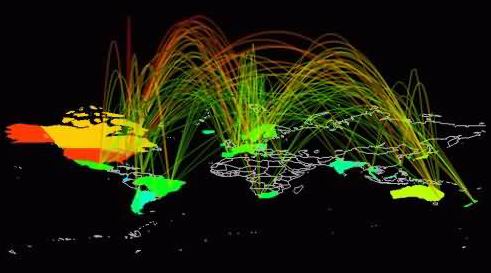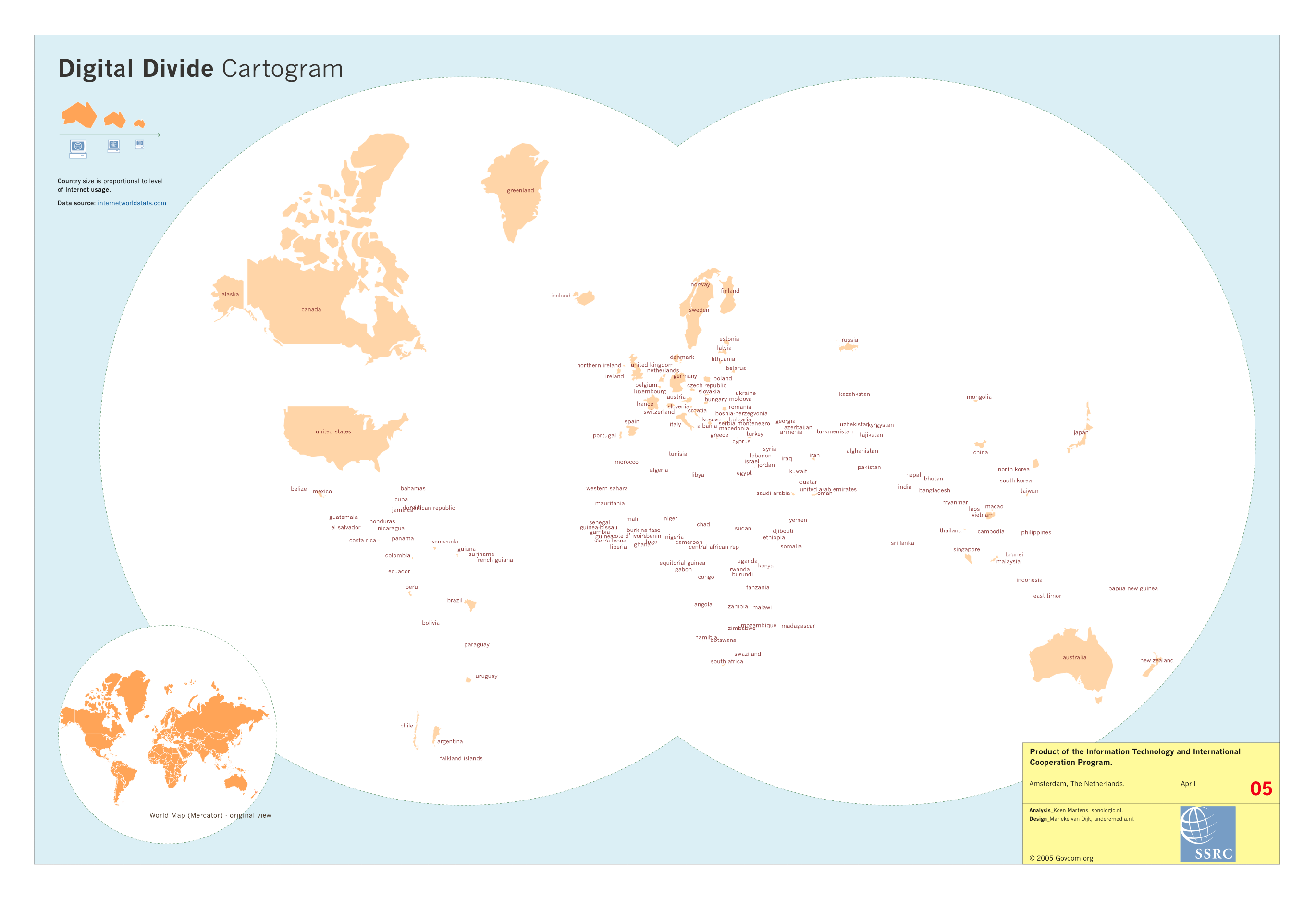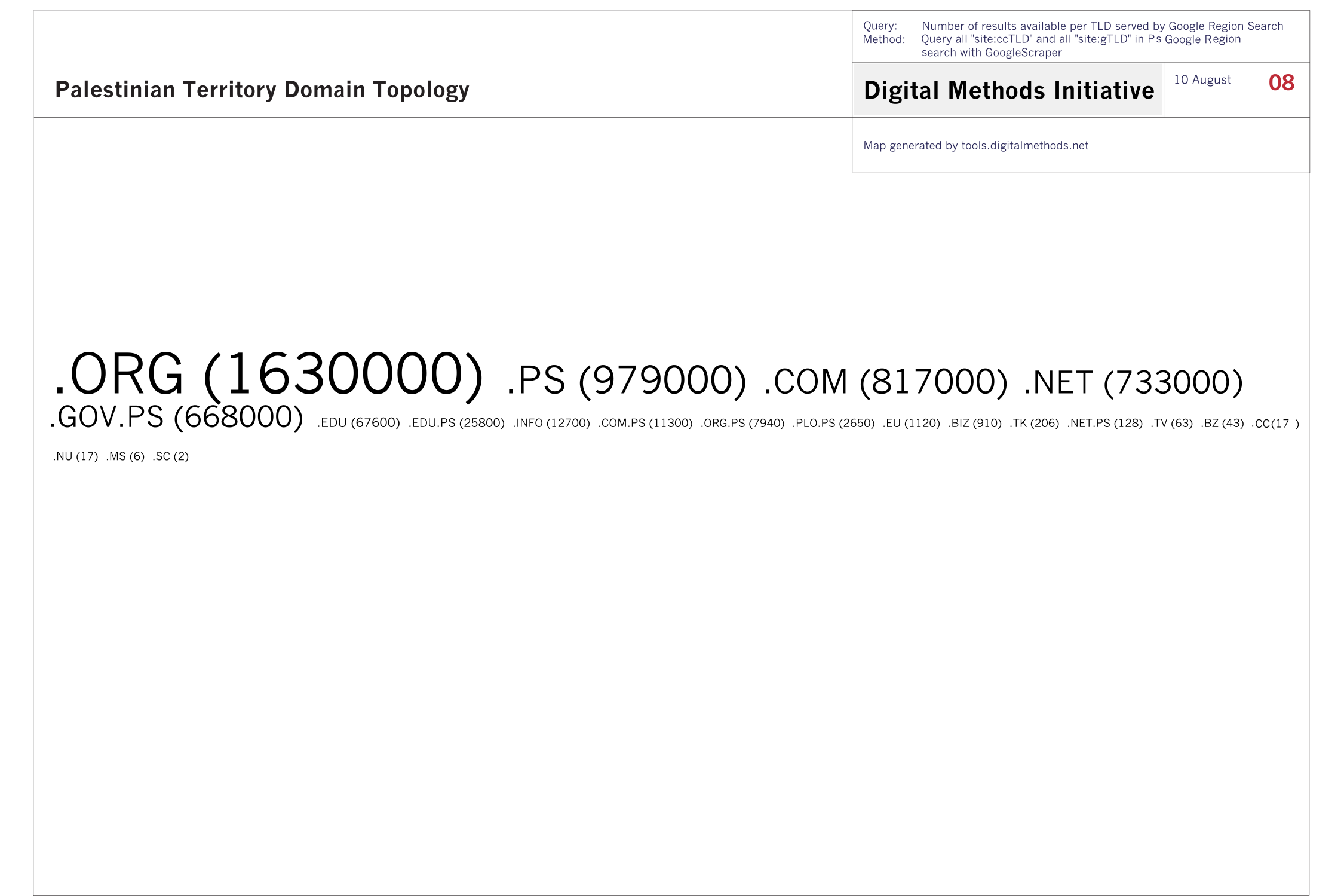You are here: Foswiki>Dmi Web>ProjectsOverview>NationalWebConditionDiagnostics (05 Sep 2008, EstherWeltevrede)Edit Attach
National Web Condition and Diagnostics
National web as object of study
Thinking geographically with the web is not inherently prearranged in the infrastructure of the Internet. Rather, the hardware infrastructure initially informed ideas of Cyberspace and its fiber-optic cable network (figure 1), designed to plug in computers wherever whenever, enabling a distributed network distinct from traditional (de)centralized mass media. The Internet’s technical indifference to the geographical location of its users and their content paralleled ideas of equality, freedom and (anonymous) identity play. Figure 1. 3D Geographic Network Display, Eick et al., 1996.
Figure 1. 3D Geographic Network Display, Eick et al., 1996. An effort to ground the internet came from virtual methods scholars arguing Internet access is not equally distributed across the globe. The cartogram made by govcom.org is probably one of the few maps within the virtual methods tradition (figure 2). That is to say, digital divide is about trying to explain the online with the offline. With digital methods the aim is to invert this. The effort is not to study the web from the ground. Rather begin by studying a variety of locative technical objects and attempt to "digitally ground the web." It approaches location from within the medium; utilizing the medium's specificity.
 Figure 2. Digital Divide Cartogram, Govcom.org, 2005
One way of looking at digitally grounded web spaces is by studying webs organized, ordered and served along national or linguistic lines.* Consider for example Google Region Search, which owing to geo2ip location serves customized results, relevant for the geographical region one is in. Google about location as a relevance meaure:
Figure 2. Digital Divide Cartogram, Govcom.org, 2005
One way of looking at digitally grounded web spaces is by studying webs organized, ordered and served along national or linguistic lines.* Consider for example Google Region Search, which owing to geo2ip location serves customized results, relevant for the geographical region one is in. Google about location as a relevance meaure:
By default, we identify your approximate city location based on your computer's IP address and use it to customize your search results. If you'd like Google to use a different location, you can sign into or create a Google Account and provide a city or street address. Your specific location will be used not only for customizing search results, but also to improve your experience in Google Maps and other Google products.*For certain global services there are country or language-specific versions, e.g., for google as well as wikipedia. Other's have not, such as Alexa, which makes it empirically possible to challenge the notion of a national web.
Demarcating a web
After recognizing webs as being organized geographically, or in this particular example nationally, the attempt is to demarcate a national web space. There are several methods to demarcate such a web space based on locative technical elements, including IP-range, domains, registering and hosting. In the following a step by step approach for demarcating a national web space by domains is provided.National Domain Name Topology
Approach
How to compare the domain topology for two national web spaces? Countries and geographical regions have assigned country code top level domains (ccTLD), delegated by IANA. Each delegated authority governs the assigned domain space and have their own policy and second level domain politics. Generatenational.net is a tool that queries and fetches Google.com for ccTLD and SLD*, as well as Google Region Search for gTLD and ccTLD.How to create a domain topology for a national web space:
1. Open http://generatenational.net and select a country by its ccTLD, select "get that national web"
2. Tick boxes of the TLDs (ccTLD, SLD and gTLD) you want to fetch
3. Copy and paste "total nr of results available" for all TLDs in a document between brackets (e.g. .be (187000000) .com (73900000) etc.)
4. Open ToolTagCloudGenerator, fill in title, method and query. Copy and paste the TLDs with number between brackets in the field. Select "Cloud to svg/pdf)
5. Repeat step 1 to 4 for a second country and compare results
6. Optional: The svg files can be adjusted in Illustrator
* SLD list is not exhaustive and needs updating. Additionally, the tool will be expanded with other leading search engines such as Yahoo!, Baidu, and Yandex.
Sample project
Comparing the topology of the Palestinian web with the United States web.1. Open http://generatenational.net and select .ps to generate the Palestinian web, select "get that national web"
2. Tick all boxes of the TLDs (ccTLD, SLD and gTLD)
3. Copy and paste "total nr of results available" for all TLDs in a document between brackets
4. Open ToolTagCloudGenerator, fill in title, method and query. Copy and paste the TLDs with number between brackets in the field. Select "Cloud to svg/pdf)
5. Repeat step 1 to 4 for a .us (United States web) and compare results
Findings

 When looking at those two tag clouds, it is striking to see over half of the United States web is commercial. While the Palestinian web is predominantly .org and .ps. before a commercial one. The Palestinian Territory is not an acknowledged state, while it has sovereignty on the web. Taking on a .ps domain for a website owner might therefore be considered a symbolic patriotic deed. In the USA web on the other hand one might expect to see a more varied ccTLD topology because of the multicultural built up of the population. We can start to explain the predominance of .org in Palestian web by looking at how the territory is governed and the socio-political situation. Palestine does not really have a government, it might interesting to study whether some government tasks have been shifted to organizations. Also, Palestine is a place with a lot of socio-political turbulence so one might expect attention of aid organizations. The lack of .com might be explained by trade barriers.
When looking at those two tag clouds, it is striking to see over half of the United States web is commercial. While the Palestinian web is predominantly .org and .ps. before a commercial one. The Palestinian Territory is not an acknowledged state, while it has sovereignty on the web. Taking on a .ps domain for a website owner might therefore be considered a symbolic patriotic deed. In the USA web on the other hand one might expect to see a more varied ccTLD topology because of the multicultural built up of the population. We can start to explain the predominance of .org in Palestian web by looking at how the territory is governed and the socio-political situation. Palestine does not really have a government, it might interesting to study whether some government tasks have been shifted to organizations. Also, Palestine is a place with a lot of socio-political turbulence so one might expect attention of aid organizations. The lack of .com might be explained by trade barriers.
National Web Generator
generatenational.net Power giving continuance to life – Nietzschian machine Get a sense of the national web by checking Alexa's national website traffic stats. Disaggregated indicators of the condition of a national web:Web diagnostics
1. Brokenness
a. Percentage of 'Brokenness'
Link Validator - Internal and external links on a site Broken link % (Outlinks: what % of the links are broken on a site?) All websites or per sector (gov, edu, etc) and check whether or not they have a lot of broken links.b. “Parked”
Futures market All websites or per sector (gov, edu, etc) and check whether or not they have a lot of parked sites. Indication of future or past (when reparked) market.c. Uptime
Are the sites down? http://uptime.netcraft.com/ http://host-tracker.com/ is it accessible? From where? See also: work by Rafal Rohozinski around elections. 72 hrs before and after elections, check whether party sites and critical newspapers and ngo sites were up.2. Vintage or Youthfulness
“ Vintage” or “Youthfulness”: the freshness and vitality characteristic of an active website Is the code and software of a website up-to-date? See also: (Website value calculator) http://www.cubestat.com/a. CSS Analysis
b. Version RSS/AJAX
c. Design Elements?
See Rosa's work for Iraqi web.3. Datedness
“Datedness”: The more dates returned the more dated the national web is. – Timestamp Analysisa) Pages with a date
Last modified with dateb) Pages that are generated when fetched
Last modified nowc) None
No date available. Erik: Maybe in the future also zeitgeist type relevance? This site was relevant on date x for query y.4. Dated users
How up to date is the user of a national Web? Browser use analysis. Maybe with Google/Alexa toolbar data?5. National Traffic
Alexa national website traffic stats How do we get site-stats?example: Iraq Case Study
Check “sectors” of society for brokenness etc. .gov ministeries (incl. second level domains) .com .org .edu .parliament| I | Attachment | Action | Size | Date | Who | Comment |
|---|---|---|---|---|---|---|
| |
03GC0_Maps_set_3.0_digitaldivide.png | manage | 401 K | 22 Aug 2008 - 15:14 | EstherWeltevrede | digital divide |
| |
07United_States_Domain_Topology01.png | manage | 150 K | 29 Aug 2008 - 09:50 | EstherWeltevrede | .us topology |
| |
08Palestinian_Territory_Domain_Topology_edited.png | manage | 158 K | 29 Aug 2008 - 09:51 | EstherWeltevrede | .ps topology |
| |
cyberspace.pdf | manage | 27 K | 22 Aug 2008 - 15:12 | EstherWeltevrede | cyberspace |
| |
cyberspace.png | manage | 23 K | 22 Aug 2008 - 15:12 | EstherWeltevrede | cyberspace |
Edit | Attach | Print version | History: r8 < r7 < r6 < r5 | Backlinks | View wiki text | Edit wiki text | More topic actions
Topic revision: r8 - 05 Sep 2008, EstherWeltevrede
 Copyright © by the contributing authors. All material on this collaboration platform is the property of the contributing authors.
Copyright © by the contributing authors. All material on this collaboration platform is the property of the contributing authors. Ideas, requests, problems regarding Foswiki? Send feedback


